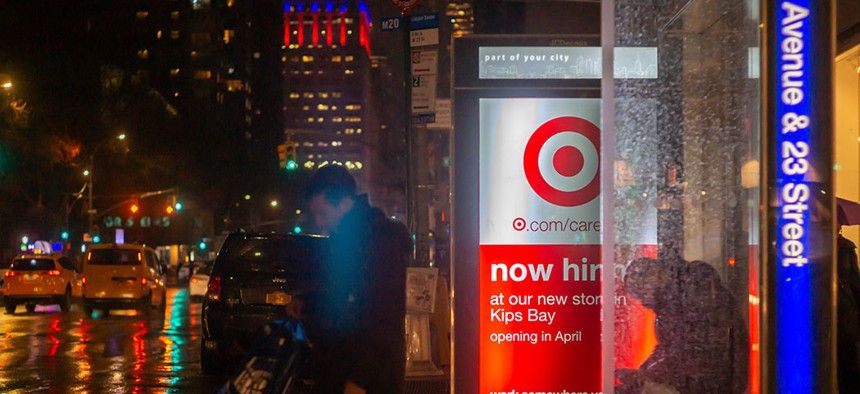The road to 5G may be a slow, winding one, but soon, when you look up from that road, you may see small antennas, nodes and other telecommunications infrastructure installed on LinkNYC kiosks, bus shelters and other street “furniture” – a development that New York City officials say is an important step in the push to expand next-generation wireless service across the city.
A city committee on Tuesday voted to approve 10 franchisees – the companies that bid on the right to install telecommunications boxes and antennae on city property – and allow companies for the first time to install that equipment on things like LinkNYC kiosks or automated public toilets (of which there aren’t many).
City officials said that expanding the number of franchisees from eight to 10 and allowing companies to install cellular equipment on new places like LinkNYC kiosks and bus shelters – instead of where we typically see it, like on street and light poles – will facilitate not only expansion of 4G service, but of coming 5G networks as well, as the latter require cellular equipment to be installed closer to the ground and closer together to take full advantage of the promised higher speeds.
As New York and other locales face increasing pressure to prepare for coming 5G service, one recurring issue for cities is figuring out how installation of the necessary equipment will work. The ultra-high-speed, remote-surgery-enabling, autonomous-vehicle-empowering “5G” that’s talked about as the foundation of the future isn’t really available yet – at least not in broad swaths. The pinnacle of what 5G is promised to offer will require usage of higher frequency bands on the radio spectrum known as millimeter wave, which only reach short distances and have trouble penetrating buildings or walls. The idea is that opening up more city infrastructure – and infrastructure that’s closer to the ground – will make it easier to install these high-frequency antennas.
The Department of Information Technology and Telecommunications oversees the city’s franchise program, and Tuesday’s changes were approved by the Franchise and Concession Review Committee, a body made up of city officials or their representatives, including the mayor, comptroller, and each of the five borough presidents.
Tuesday’s vote wraps up a request for proposals from companies wishing to expand wireless connectivity that DoITT issued in 2018. This past June, New York City Comptroller Scott Stringer came down hard on DoITT for lagging on laying the groundwork for 5G – and for not making awards on that 2018 RFP. “To do something like this, to build a new cellular network that is going to be the network of the future, you have to take a very thoughtful approach, and you have to take it very seriously,” DoITT Commissioner Jessica Tisch told City & State.
Additional franchisees are expected to be added soon, and Tisch said new players would increase competition in the push for 5G. The next step for DoITT, meanwhile, will be to open up a new reservation phase, during which franchisees will bid on the right to install the equipment on specific pieces of “street furniture,” like the individual LinkNYC kiosks.
Currently, companies like Verizon and AT&T offer 5G service in New York City and other cities, but for the most part, it’s of the low-band variety. AT&T, for example, calls its millimeter wave network 5G+. And only a handful of very expensive cell phones work on the available 5G networks.
So while it may be a while before 5G service is affordable and accessible for all New Yorkers, these new franchise agreements are a step in that direction. "Today's vote goes a long way toward ensuring full coverage across all five boroughs – not just in the commercial corridor – enabling more companies to come in and build out on more infrastructure,” Tisch said.


